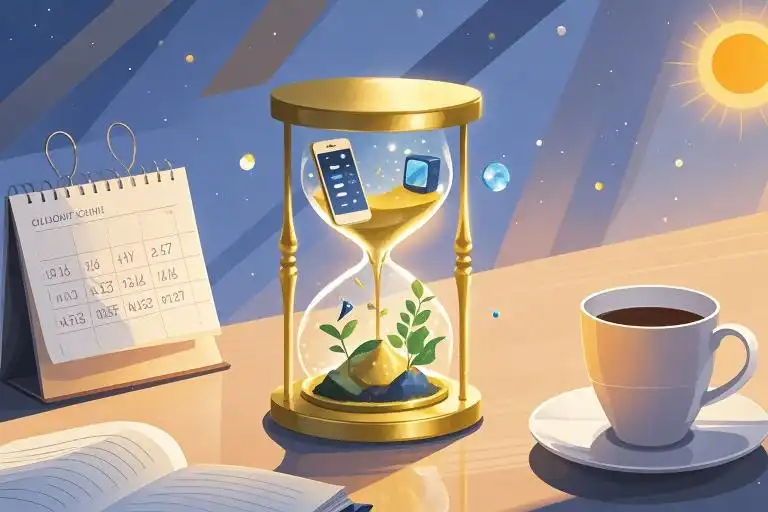You’ve likely muttered these words today: “I just don’t have time.”
Yet here’s the uncomfortable truth—you spent 23 minutes deciding what to watch on Netflix last night. Scrolled through 47 TikTok videos while waiting for coffee. Lost 18 precious morning minutes hitting snooze. We all do.
But what if I told you that the secret to learning Spanish, writing a novel, or getting fit isn’t found in dramatic overhauls? That transformation hides in plain sight—in the exact same minutes we’re already wasting?
Let’s talk about magic hiding in 60 minutes.
The Modern Time Paradox
Picture this: You’re holding $86,400 in cash. Every morning, your bank deposits another $86,400. There’s just one rule—you must spend it all by midnight.
How would you use it?
This isn’t a hypothetical—it’s your daily 86,400 seconds. And like most people, you’re probably letting thousands slip through your fingers on autopilot activities. The average adult spends 3 hours 15 minutes daily on screens outside work. That’s 1,170 minutes weekly—enough to:
- Learn conversational French (20 hours)
- Write a short story (10 hours)
- Train for a 5K (8 hours)
Yet when we try to redirect just 60 of those minutes toward growth? Cue the excuses:
“I’m too tired after work.”
“My schedule’s packed with family stuff.”
“I’ll start when life calms down.”
Here’s the kicker: Your brain’s lying to you.
Why 60 Minutes Feels Impossible (When It’s Not)
Neuroscience reveals two sneaky tricks our minds play:
- The “Empty Jar” Fallacy
We see time as a container to fill—work, chores, sleep. What’s left feels like crumbs. But high achievers treat time like clay, reshaping it through what Cal Newport calls “time blocking”. - The 2-Day Rule Sabotage
James Clear’s research shows missing two consecutive days of a habit makes abandonment 80% likely. We overestimate daily effort but underestimate compound results.
Let me show you how to hack both.
The Micro-Investment Playbook
Step 1: Redefine “Productivity”
Forget grinding. True progress feels like planting acorns, not moving mountains.
Try this experiment:
- Track all screen time for 3 days (Instagram’s “Your Activity” tool works)
- Highlight non-essential minutes in red
- Steal back just 10%
You’ll likely find 60+ redeemable minutes. Now the fun begins.
Step 2: Design Your “Golden Hour”
Your brain craves rhythm. Stanford psychologist Kelly McGonigal recommends anchoring growth time to existing routines:
Early Bird Template:
☕ 6:00 AM – Coffee brewing (5 min)
🧘 6:05 – Yoga flow (20 min)
📖 6:25 – Read industry news (15 min)
✍️ 6:40 – Journaling (10 min)
👔 6:50 – Prep work outfit (10 min)
Night Owl Template:
🌙 9:00 PM – Phone on airplane mode
🎹 9:05 – Piano practice (25 min)
📚 9:30 – Online course (25 min)
🛀 9:55 – Wind-down routine (10 min)
Notice the secret sauce: Transitional buffers. These 5-10 minute gaps prevent the “all or nothing” crash.
Step 3: Leverage the 1% Compound Effect
Warren Buffett’s favorite concept applies beautifully here. Investing 60 daily minutes equals:
- 7 hours weekly
- 30 hours monthly
- 365 hours annually
To put that in perspective:
- Fluent in Spanish: 600 hours → Achievable in 1.6 years
- Write a book: 200 hours → Done in 7 months
- Marathon-ready: 80 hours → 3 months
But here’s what no one tells you—the first 20 hours matter most. Josh Kaufman’s First 20 Hours method proves rapid skill acquisition comes from:
- Deconstructing the skill
- Learning enough to self-correct
- Removing practice barriers
- Pre-committing to 20 hours
Overcoming the Invisible Enemy
Even with the best plans, three stealthy villains attack consistency:
Villain 1: Decision Fatigue
Solution: Pre-make choices
- Sunday meal prep → saves 15 min/day → 91 annual hours
- Lay out clothes nightly → saves 7 min/day → 42.5 hours/year
Villain 2: The “I Don’t Feel Like It” Monster
Solution: The 2-Minute Trick
Commit to just 120 seconds of your activity. Usually, momentum takes over.
Villain 3: Progress Blindness
Solution: Visual tracking
Mark an X on a calendar for each completed hour. Jerry Seinfeld’s “Don’t Break the Chain” method creates addictive momentum.
Real People, Radical Results
- Sarah, 34 (Nurse): Used lunch breaks to learn medical coding → $18k salary bump in 14 months
- Diego, 28 (Barista): Practiced copywriting nightly → Landed first freelance client in 73 days
- Grandma Lois, 61: Dedicated morning hour to watercolor painting → Now sells prints on Etsy
Their secret? They treated the hour like a dental appointment—non-negotiable.
Your Turn
Tonight, as you reach for the remote, pause. Ask:
“Will this episode matter in 5 years? What could?”
That’s your power minute. Your turning point.
Time isn’t the enemy—it’s the canvas. And 60 minutes? That’s your daily brushstroke. Paint boldly.




